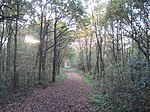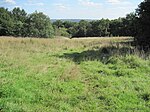Copthall South Fields
Nature reserves in the London Borough of BarnetParks and open spaces in the London Borough of Barnet

Copthall South Fields is a six hectare Site of Local Importance for Nature Conservation, next to Fiveways Corner on the A1, in Mill Hill in the London Borough of Barnet.It has several fields with scattered trees and ancient hedgerows. The trees are mainly oak, ash and field maple. The fields contain wild flowers such as meadow vetchling and meadow buttercup, and there are stands of tall herbs. A small plot of native woodland has been planted in the northern field by Watling Chase Community Forest.There is access from Page Street, near Fiveways Corner, and from Champions Way.
Excerpt from the Wikipedia article Copthall South Fields (License: CC BY-SA 3.0, Authors, Images).Copthall South Fields
Champions Way, London Mill Hill (London Borough of Barnet)
Geographical coordinates (GPS) Address External links Nearby Places Show on map
Geographical coordinates (GPS)
| Latitude | Longitude |
|---|---|
| N 51.602 ° | E -0.233 ° |
Address
Copthall South Fields
Champions Way
NW7 2EE London, Mill Hill (London Borough of Barnet)
England, United Kingdom
Open on Google Maps







